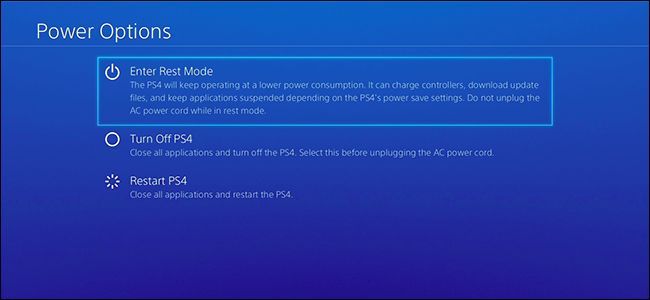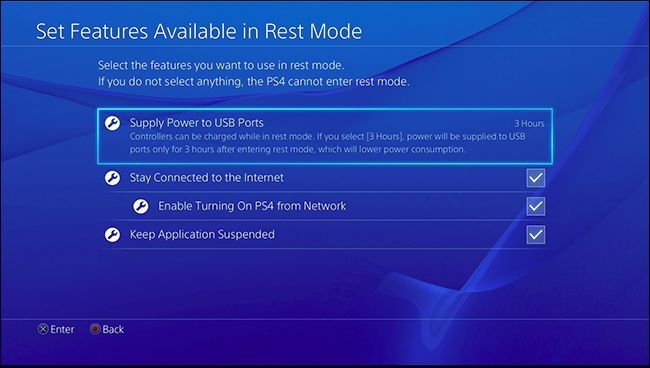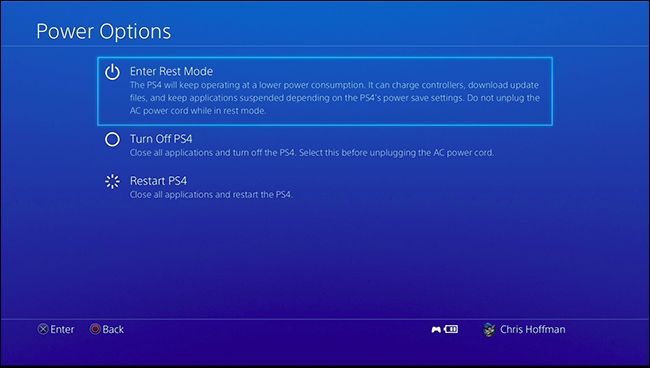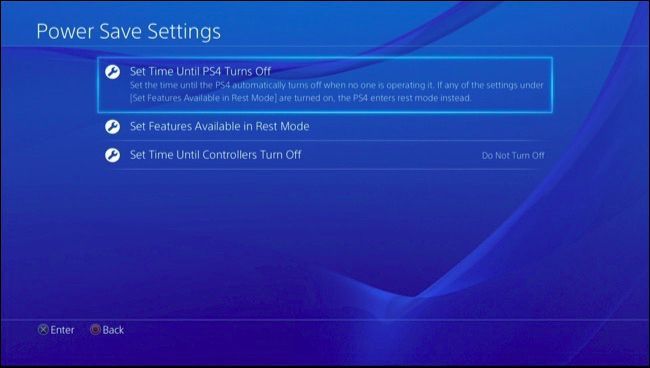Quick Links
Sony encourages you to use "Rest Mode" on your PlayStation 4 instead of completely powering it off. Rest Mode is a bit like sleep mode on your PC--it goes into a low-power mode instead of turning off entirely, so you can get to your games faster when you wake it up. The only downside to using Rest Mode is that it uses more energy than turning your PS4 off--but how much more, and how much does it cost?
The PlayStation 4 uses less energy than the Xbox One, and its rest mode is more customizable--you can reduce its energy usage by disabling features you don't care about.
What Is Rest Mode?
In Rest Mode, your PlayStation 4 isn't fully shut down. When you turn it on again, it will power on in a second or two rather than going through a 30 second or longer boot-up process. It can download game updates and operating system updates in the background, so your games are always up-to-date. If you buy a game online, you can tell your PS4 to install it--if it's in Rest Mode, it will automatically install it. Thanks to PS4 System Update 2.5, games also suspend when you use Rest Mode. You can turn on your PS4 and immediately start playing the game from where you left off without sitting through load screens and loading from a save file.
In short, Rest Mode makes everything more convenient. The PS4 was designed to be put into Rest Mode when you're not actively using it. The only downside to using Rest Mode is that it uses more electricity than turning off your PS4.
How Much Energy Does Rest Mode Use?
In Rest Mode, your PS4 reportedly uses about 10W of power with the default settings. When it's powered off, it uses about 0.3W instead--it needs some power so it can listen for the controller input that powers it on.
So let's say you left your PS4 on in rest mode for an entire year without ever touching it, and it was using 10W of power the whole time. How much does that cost you? The exact cost depends on the electricity rates in your area, but here's how to calculate it.
Electricity rates are given in cents per Kilowatthour, or kWh. First, we'll figure out how much electricity 10W is in terms of kWh. This is how much electricity a PlayStation 4 in Rest Mode will use in an hour.
10W / 1000 = 0.01kWh
Next, we multiply this by the number of hours in a day (24) and the number of days in a year (365). This shows us how many kWh Rest Mode mode uses over an entire year:
0.01kWh * 24 * 365 = 87.6kWh
Multiply that number by the cost of electricity in your area to find out how much that will cost you. We'll use 12.15 cents per kWh here, as that's the average cost of electricity across the US in February 2016, according to the US Energy Information Administration. Check your electric company's website or your electricity bill to find the rate in your area.
87.6kWh * 12.15 = 1064.34 cents
Now all we have to do is convert that figure to dollars by moving the decimal point over two places:
1064.34 cents / 100 = $10.64
On average, it will cost $10.64 to keep a PlayStation 4 on in Rest Mode for an entire year in the USA. To get an exact number for year area, just take 87.6kWh and multiply it by your electricity rate.
Another quick calculation shows that a powered off--but still plugged in--PS4 uses 4.38kWh per year, for an average cost of $0.32 per year.
This is a rough estimate, of course. It assumes you're leaving your PS4 in Rest Mode for an entire year if you're using it. It also assumes your PS4 takes up 10W of power at all times, while you can reduce this to save power--that's the maximum. In real use, your PS4 can use much less power in Rest Mode if you change one simple setting.
How to Reduce Rest Mode's Energy Usage
You can reduce the amount of energy Rest Mode uses by trimming various features. Head to Settings > Power Save Settings> Set Features Available in Rest Mode to find them.
- Supply Power to USB Ports: Your PS4 needs to supply power to its USB ports to charge controllers while in Rest Mode. You can choose Always, 3 Hours, or Off. If you choose Always, the console always supplies power to its USB ports. If you choose 3 Hours, it will supply power for just 3 Hours after it enters Rest Mode--enough time for the controllers to charge if you plug them in after entering Rest Mode. If you select Off, the PS4 will never provide power to its USB ports. 3 Hours is a good compromise, allowing your PS4 to charge controllers in Rest Mode without the constant power usage.
- Stay Connected to the Internet: This controls whether the PS4 stays connected to the Internet and downloads game updates, operating system updates, and new games you've purchased while in Rest Mode.
- Enable Turning on PS4 From Network: This feature allows you you to turn your PS4 on from over the network. It's particularly useful if you use a PS4 Remote Play on your Windows PC, Mac, or Android device.
- Keep Application Suspended: This keeps the current game you're playing (or application you're using) suspended in the background so you can continue playing right where you left off after the PS4 comes out of Rest Mode.
According to Ars Technica, "Supply Power to USB Ports" uses 6.3W while it's on. "Stay Connected to the Internet" and "Enable Turning On PS4 From Network" use a combined total of 2.4W. "Keep Application Suspended" uses 1.2W. Sony doesn't offer information about the power consumption as Microsoft does, so we have to rely on third-party test results.
If you set your PS4 to only supply power to its USB ports for 3 Hours, it will actually use about 3.7W of power in Rest Mode instead of 10W. That works out to about $3.94 per year, and you still get the network connectivity and game-suspend features.
Which Should You Use?
If you never use your PS4 and leave it sitting around for months on end, you may want to consider turning off your PS4 instead of putting it into Rest Mode. The benefits of instantly resuming your gameplay don't matter if you never touch your console.
But, in practically all other cases, you're better off leaving your PS4 in Rest Mode. Tell it to only supply power to the USB ports for 3 hours and you'll cut the power usage--and cost--of Rest Mode by more than half. After all, Rest Mode is a big time saver if you do use your PS4. And, even if you don't use it often, Rest Mode will keep your games and software up to date so you won't have to wait for downloads when you do want to use it.
How to Turn Off Your PS4 Instead of Using Rest Mode
Your PS4 uses Rest Mode by default, so if that's what you want, you're done! But if you want to actually turn your PS4 off, long-press the PlayStation button at the center of your controller. Select "Power Options" and then select "Turn Off PS4" instead of "Enter Rest Mode."
That will just turn your PS4 off that one time, however. If you'd prefer your PS4 turn off by default, instead if entering Rest Mode, you just need to turn all of Rest Mode's features off. Head to Settings > Power Save Settings > Set Features Available in Rest Mode and disable all of the features. Your PS4 will turn off by default from now on.
You can also change how long your PS4 waits to turn off as well. From that same Power Save Settings menu, choose "Set Time Until PS4 Turns Off" and you can configure how long the PS4 waits until it turns itself off. If you disable all the features normally available in Rest Mode, the PS4 will turn off instead of entering Rest Mode after this time period expires.
Even if you do configure your PS4 to normally use Rest Mode, you can long-press the PlayStation button on your controller and select "Turn Off PS4" to turn it off whenever you like. It won't enter Rest Mode again until you turn it on. You should always turn off your PS4 before unplugging it from the power outlet.




